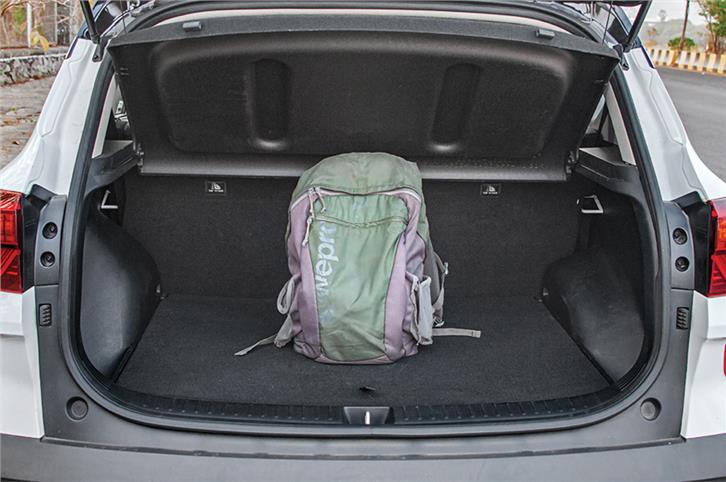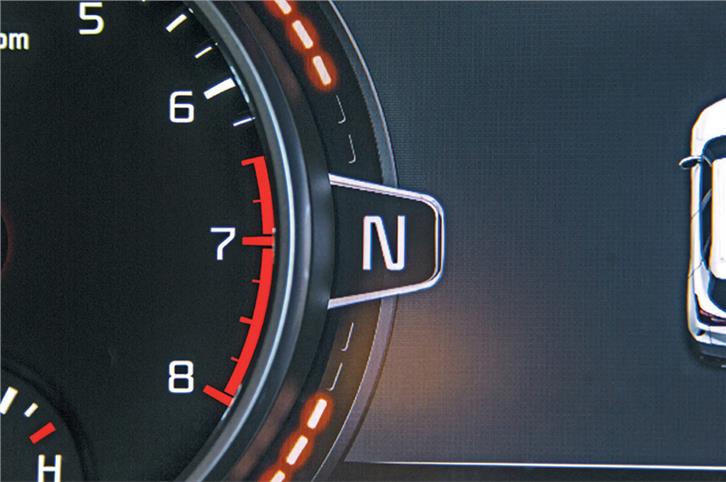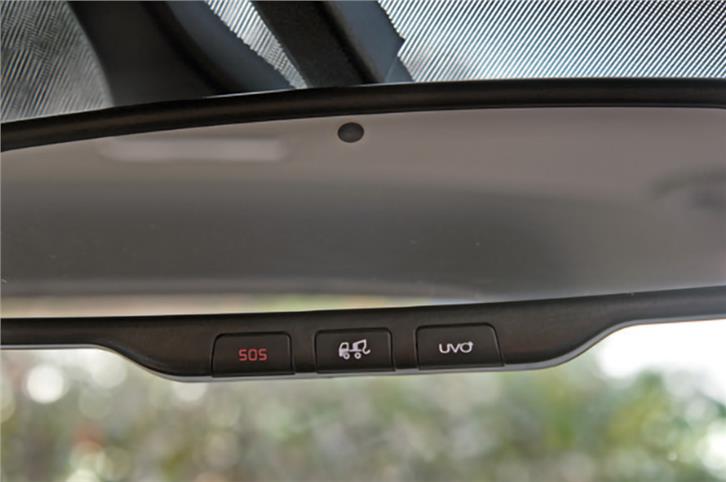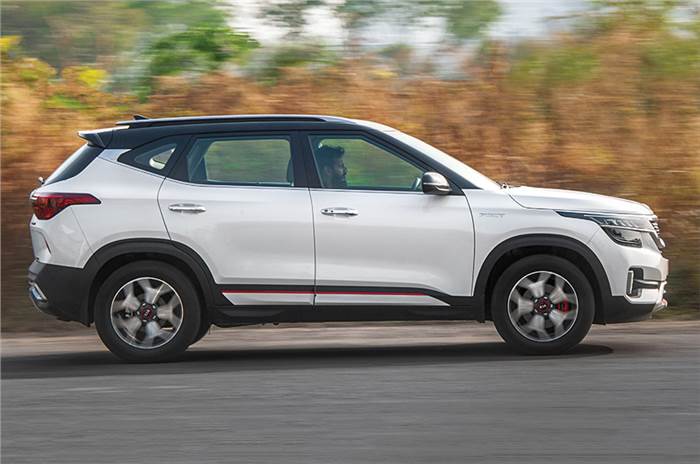Kia Seltos review, road test
We put Kia’s first offering in India through our exhaustive test to find out whether it is worthy of the hype.
Published on Apr 04, 2020 06:00:00 AM
1,67,110 Views
Follow us on

At 433 litres, the boot can accommodate a decent load of luggage.

Gearshift lights in Sport mode lend a racy feel, but DCT feels too snappy for city driving.

It’s easy to accidently press SOS button while adjusting the mirror.
Kia is offering buyers a choice of three different engines – a 115hp, 1.5-litre naturally aspirated petrol; a 140hp, 1.4-litre turbo-petrol; and a 115hp, 1.5-litre diesel engine. Each of these get a 6-speed manual and an automatic option as well. What’s unique is that each automatic transmission is exclusive to each powertrain. The 1.5-litre petrol gets a CVT (continuously variable transmission), the 1.4-litre turbopetrol gets a 7-speed DCT (dualclutch transmission), and the diesel gets 6-speed torque converter automatic. Kia has taken the lead in its segment by introducing BS6-compliant engines – for which the catalytic converters in the petrols have received some tweaks, but changes to the diesel are more significant like the addition of a highpressure pump, a catalytic converter with a diesel particulate filter (DPF), and a lean NOx trap (LNT).
With power and torque figures of 140hp and 242Nm, respectively, the 1.4-litre turbo-petrol motor surely impresses on paper, and even more so in the real world. Refinement levels are top-notch, and even on the move it goes about doing its job in a silent manner. Those with a keen ear will hear a faint whistle-like sound from the intake past 2,000rpm when the engine is under load. Beyond 5,000rpm, the engine sounds a bit boomy. Throttle responses are sharp, and because max torque comes in from as low as 1,500rpm, there’s no perceptible delay in performance. Spin it past 2,200rpm and the tachometer needle swings towards the redline in a rather enthusiastic manner. While performance in the mid-range is strong, there’s no prominent spike in power delivery, so it builds speed in a very linear manner. Hold on to a gear longer and it will spin past 5,000rpm in a gutsy manner, although power begins to taper off beyond 6,000rpm. The 6-speed manual’s gearing is very tall, so it will rev until 6,800rpm in the first three gears, with the first maxing out at 54kph, second at 99kph, and third at 149kph. The tall gearing and impressive torque spread shoots the Seltos from 0-100kph in a rapid 8.9sec, making it the quickest sprinter in India under Rs 20 lakh. Acceleration through the gears is equally impressive, despite the taller ratios. The manual transmission is a delight to use, with slick shifts that provide a reassuring click each time the gear slots into its gate. The clutch, although light, has a long travel, and the pedal feel isn’t consistent, so you’ll need to modulate it carefully to drive smoothly.

Paired to the turbo-petrol is also a 7-speed dual-clutch automatic transmission. This unit is fairly quick like most twin-clutch units and is almost always in the right gear. There are driving modes too, and in ‘Normal’ and ‘Eco’, it shifts to the highest gear possible at the earliest; for example, it shifts to sixth gear by 60kph and seventh by 80kph. Within urban confines, there’s barely any difference between the two modes; so the Eco mode feels very usable, and it doesn’t blunt performance or responsiveness either. However, it does reduce the effectiveness of the air conditioning, and this can be uncomfortable on a hot day. The third driving mode is ‘Sport’, which sharpens throttle responses, weights up the steering and programmes the transmission to hold onto gears longer. But what it does is also aggravate the snappy engagement of the DCT which isn’t very userfriendly in start-stop traffic. In fact, one of the weaknesses of the Seltos’ DCT is that clutch engages a bit too sharply and it doesn’t have a progressive feel. Backing into a parking spot in reverse can be tricky because of this sudden engagement. It’s also important to point out that the Seltos DCT did face overheating issues because of excessive clutch ‘slip’ in stop-start traffic. A new software update has reduced the slip but the clutch now engages more like an on-off switch, making it feel a touch too snappy. Paddleshifters would have enhanced the drive experience but the Tiptronic mode does offer the option to change gears manually. The Seltos DCT has a few rough edges and is clearly not as smooth or refined as Volkswagen’s DSG unit, which, in terms of shift quality, is still the benchmark.
The Kia Seltos’ 1.5-litre diesel sets a new benchmark in its segment in terms of refinement and drivability. The motor is extremely smooth and the diesel clatter or drone is well in check. What’s nice is that power delivery is linear, and just like the turbo-petrol, this diesel makes its max torque of 250Nm right from 1,500rpm, so lag is minimal. Lazy drivers will be happy to drive around town in higher gears without the need to downshift often; it can easily exit a speed breaker in second gear, without any juddering. The real meat of the powerband is between 2,200rpm and 4,000rpm, making it a great cruiser; overtaking in this range feels effortless. While the bottom-end and mid-range are rather impressive, it does run out of breath towards its top-end; so even though the engine will spin until about 5,000rpm, it begins to sound clattery and rather coarse beyond 4,000rpm, with barely any energy left in the last 1,000rpm. The 6-speed manual, just like the turbo-petrol’s unit, has a very positive shift action, and although its clutch requires a bit more effort than the turbo-petrol’s, the pedal feel is far more linear and easier to judge. Being down on power compared tothe Creta 1.6-litre diesel-manual results in a slower 0-100kph time of 11.67sec, (Creta’s is 10.81sec), but the Kia simply blows away the Creta when it comes to drivability – 20-80kph in third gear is 1.58sec faster, and 40-100kph in fourth gear is 1.57sec faster, reflecting on how much more drivable the Seltos is compared to the Hyundai.
The 6-speed torque converter automatic is smooth and performs seamlessly while cruising. Demand for quicker responses, however, and it is slow to respond. Pin the accelerator to the floor, and it will upshift at around 4,500rpm in the lower gears, but the transition between the ratios seems rather lazy. This combination feels best when driven in a sedate manner.
Last but definitely not the least is the 1.5-litre, four-cylinder petrol engine that puts out a healthy 115hp and 144Nm of torque. And while Kia has the performance part covered with the 1.4 turbo-petrol unit, this 1.5, naturally aspirated petrol engine focuses more on a smooth driving experience. From the moment you start the engine, it feels refined and also runs quietly at low to mid revs. It’s only in the upper reaches of the powerband that it feels strained and the engine noise gets intrusive. Off the line, power delivery is smooth and the engine feels responsive to the slightest of throttle inputs. It doesn’t have the mid-range punch of its turbocharged siblings but doesn’t feel gutless like many naturally aspirated engines. It’s only beyond 4,000 rpm that it starts running out of breath.
This engine is offered with a CVT and it does the job well. Yes, it does have the typical rubber-band effect seen in most CVTs, where you accelerate hard and the engine RPM rises but doesn’t translate into a rise in speed. However, the good news is that this undesirable effect has been kept to a minimum, which means there’s enough power while overtaking on the highways. While the instant low-speed response is impressive, especially on part throttle, there’s a momentary delay before the gearbox responds, and that’s not something you expect in a modern CVT. There’s a manual mode to move through predefined ratios but it doesn’t allow aggressive downshifts for engine braking. On the other hand, during outright acceleration, the manual mode holds on to each ratio slightly longer than in ‘D’. All in all, this combination works really well if you have a laid-back driving style.
Copyright (c) Autocar India. All rights reserved.






Comments
Member Login
Personal Details
No comments yet. Be the first to comment.